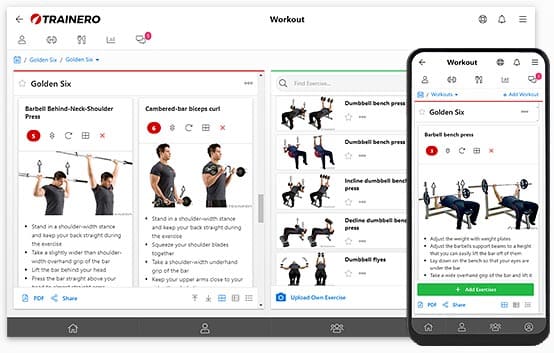Those looking to become a personal trainer often wonder about the potential financial rewards. Understanding personal trainer salaries is crucial for anyone considering this career path. Whether you are an aspiring trainer or an experienced personal trainer, knowing how much do personal trainers make can help you make informed decisions about your career trajectory in this competitive industry.

Unlock your fitness potential with Trainero! Get a 14-day free trial and access personalized workout plans, expert coaching, and progress tracking—all in one app. No commitments, just results. Start your free trial today and take your fitness journey to the next level!

Personal Trainer Salaries
Personal trainer salaries can vary significantly based on several factors. A certified personal trainer salary is influenced by the type of certification held, level of experience, and the region where they operate. For instance, a personal trainer and nutritionist may command higher earnings than one focusing solely on fitness training. Additionally, the choice between working as a trainer at a gym or pursuing independent personal training also impacts potential earnings. Understanding these variables is essential for maximizing personal trainer income.
Factors Influencing Personal Trainer Income
Several factors influence personal trainer income, including the type of personal trainer certification obtained and the specific trainer program completed. Certified personal trainers with advanced qualifications, such as a master trainer designation, often earn more. Location plays a crucial role, as the trainer salary in the United States can differ based on the state or city. Specializing in areas like group fitness or becoming an online trainer can also enhance earning potential. Moreover, experienced personal trainers tend to earn more than those at the entry-level.
Average Annual Salary for Personal Trainers
The average annual salary for personal trainers is subject to fluctuation based on the factors previously mentioned. Entry-level personal trainer salary tends to be lower, with opportunities for growth as trainers gain experience and build their client base. On average, trainers working full-time can expect to earn a decent salary as a personal trainer, although it may take time to reach the higher pay brackets. The fitness trainer salary can range widely, but dedication and skill development often lead to increased earnings over time.
Comparing Salaries: Gym Trainers vs. Independent Trainers
When comparing salaries, gym trainers and independent trainers often experience different earning dynamics. A trainer at a gym may have a more stable income, often paid per hour or through salaried positions. In contrast, an independent trainer might have the potential to earn more by setting their own rates for private personal training sessions. However, independent trainers also shoulder responsibilities like marketing and scheduling. Weighing the pros and cons of each option is vital for those considering their path within the fitness professional landscape.
How Much Do Personal Trainers Make?
Salary Breakdown by Experience Level
Personal trainer salaries are significantly influenced by the trainer’s experience level. Entry-level personal trainer salaries typically start lower as these trainers are in the early stages of building their client base and honing their skills. As trainers gain experience, their earnings tend to rise. Experienced personal trainers with a well-established reputation and a broad client portfolio can command higher rates per hour. Many seasoned trainers also diversify their services by offering additional programs, such as group fitness classes or personalized training sessions, further enhancing their income potential in the competitive fitness industry.
Income Potential for Certified Personal Trainers
Certified personal trainers often have a higher income potential due to the credibility and trust their certification provides. A certified personal trainer salary can vary widely depending on the specific personal trainer certification obtained and the specialization pursued. Those who invest in advanced certifications, like a master trainer designation, may earn more. Additionally, personal trainers who expand their services to include nutrition advice, online personal training, or specialized fitness programs may see increased earnings. Overall, the salary for a personal trainer is strongly linked to their qualifications, expertise, and ability to attract and retain clients.
Impact of Location on Personal Trainer Salaries
The location in which a personal trainer operates can have a substantial impact on their salary. Trainer salaries in the United States differ greatly from state to state and even between cities. Trainers in metropolitan areas or regions with a high cost of living typically earn more to match the market demand. Additionally, the presence of numerous gyms and fitness facilities in such areas can create more opportunities for trainer jobs. Conversely, trainers in rural areas might earn less, although they may face less competition. Understanding the geographic factors affecting personal trainer income is crucial for anyone looking to maximize their earnings in this field.
Becoming a Personal Trainer
Steps to Obtain Personal Trainer Certification
Obtaining a personal trainer certification is a vital step for those looking to enter the fitness industry. The journey to become a personal trainer begins with selecting a reputable certification program that aligns with your career goals. Various organizations offer personal training certifications, each with different prerequisites and focuses. It’s crucial to research and choose a program that is accredited and recognized within the industry. Once enrolled, candidates typically undergo a combination of theoretical and practical training sessions. After completing the program, aspiring trainers must pass an examination to become certified personal trainers, opening doors to numerous trainer jobs.
Choosing a Personal Trainer Program
Choosing the right personal trainer program is essential for building a successful career in personal training. Prospective trainers should consider several critical factors:
- Programs offering comprehensive curricula covering anatomy, exercise science, and nutrition, which are critical components for effective personal training.
- Programs providing hands-on experience and mentorship opportunities, which can be advantageous.
Evaluating factors such as program cost, duration, and the support provided for job placement can guide candidates in making an informed decision. Furthermore, some programs may offer specialized tracks, such as group fitness or online personal training, catering to different areas of interest within the fitness profession.
Transitioning from Beginner to Experienced Trainer
Transitioning from a beginner to an experienced personal trainer involves continuous learning and skill development. Here are some steps in this journey:
- Initially, entry-level personal trainers may start by working at a gym to gain practical experience and build a client base.
- As trainers accumulate experience, they can explore opportunities to specialize, such as becoming a personal trainer and nutritionist or focusing on niche markets like elite trainer packages.
Networking with other fitness professionals and attending workshops can enhance their expertise. Over time, experienced personal trainers may increase their rates per hour, expand into online personal training, and even consider roles as independent trainers, maximizing their income potential in the fitness industry.
Types of Personal Training Careers
Working as a Gym Trainer
Working as a gym trainer is often the starting point for many in the fitness industry. As a trainer at a gym, individuals typically earn a stable salary per hour, which can be appealing for those new to the profession. Certified personal trainers in this role have the opportunity to work with a diverse range of clients, from beginners to those with advanced fitness goals. Gyms provide a structured environment that can be beneficial for trainers seeking to enhance their skills and gain valuable experience. The personal trainer job within a gym setting often includes conducting training sessions, leading group fitness classes, and providing personalized exercise plans to gym members.
Opportunities for Independent Personal Trainers
Independent personal trainers enjoy the flexibility to set their own schedules and rates, potentially leading to a higher personal trainer income. Unlike a gym trainer, an independent personal trainer can cater to specific demographics, offering personalized training sessions tailored to individual client needs. This role requires a proactive approach to marketing and networking to build a solid client base. Many independent trainers also choose to diversify their services by offering nutrition advice or specialized programs, such as an elite trainer package. While it comes with challenges, the autonomy and earning potential make this an attractive career path for experienced personal trainers.
Exploring Online Personal Training Options
The rise of digital platforms has expanded opportunities for personal trainers, allowing them to explore online personal training options. Online trainers can reach a global audience, offering customized workout plans and virtual training sessions to clients worldwide. This model provides flexibility and a unique opportunity to earn as a personal trainer without geographical constraints. Developing a strong online presence through social media and digital marketing is crucial for success in this domain. Certified trainers who embrace technology and continuously adapt their offerings to meet client demands can significantly increase their personal trainer annual salary by tapping into this growing market.
Additional Income Opportunities for Personal Trainers
Personal Trainer and Nutritionist Roles
Combining roles as a personal trainer and nutritionist can enhance a trainer’s marketability and income potential. Clients often seek comprehensive health and wellness guidance, making this dual role highly valuable. Certified personal trainers who further their education with nutrition certifications can offer holistic programs that address both fitness and dietary needs. This integrated approach allows trainers to charge premium rates, boosting their personal trainer salaries. By providing clients with a one-stop solution for their health goals, trainers can effectively differentiate themselves in the competitive fitness industry, leading to increased demand and a higher salary as a personal trainer.
Private Personal Training Services
Offering private personal training services is a lucrative avenue for trainers looking to maximize their earnings. Private sessions allow trainers to provide undivided attention and tailored workout plans, often at a higher rate per hour compared to group settings. The average private personal trainer can charge significantly more by focusing on individualized client needs and achieving specific fitness outcomes. This personalized service appeals to clients seeking one-on-one attention and customized programs. Building a strong reputation and client testimonials are essential for success in this area, enabling trainers to command higher fees and enhance their personal trainer income over time.
Expanding Your Services as an Online Trainer
Expanding services as an online trainer offers personal trainers the chance to diversify their offerings and increase their income. By leveraging technology, trainers can provide virtual training sessions, online workout programs, and even virtual group fitness classes. This expansion allows trainers to reach a broader audience and offer flexible options for clients who prefer remote training. Online trainers can create subscription-based models or sell digital fitness products, generating additional revenue streams. Embracing online training not only boosts the salary for personal trainers but also provides an opportunity to stay competitive in the evolving fitness landscape.

Unlock your fitness potential with Trainero! Get a 14-day free trial and access personalized workout plans, expert coaching, and progress tracking—all in one app. No commitments, just results. Start your free trial today and take your fitness journey to the next level!











